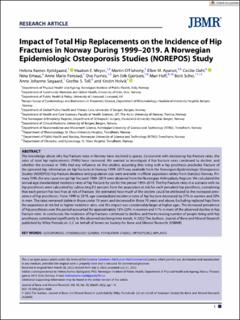| dc.contributor.author | Kjeldgaard, Helena Kames | |
| dc.contributor.author | Meyer, Haakon Eduard | |
| dc.contributor.author | O’Flaherty, Martin | |
| dc.contributor.author | Apalset, Ellen Margrete | |
| dc.contributor.author | Dahl, Cecilie | |
| dc.contributor.author | Emaus, Nina | |
| dc.contributor.author | Fenstad, Anne Marie | |
| dc.contributor.author | Furnes, Ove Nord | |
| dc.contributor.author | Gjertsen, Jan-Erik | |
| dc.contributor.author | Hoff, Mari | |
| dc.contributor.author | Schei, Berit | |
| dc.contributor.author | Søgaard, Anne-Johanne | |
| dc.contributor.author | Tell, Grethe Seppola | |
| dc.contributor.author | Holvik, Kristin | |
| dc.date.accessioned | 2022-09-27T11:33:58Z | |
| dc.date.available | 2022-09-27T11:33:58Z | |
| dc.date.created | 2022-07-26T10:06:07Z | |
| dc.date.issued | 2022 | |
| dc.identifier.issn | 0884-0431 | |
| dc.identifier.uri | https://hdl.handle.net/11250/3021759 | |
| dc.description.abstract | The knowledge about why hip fracture rates in Norway have declined is sparse. Concurrent with decreasing hip fracture rates, the rates of total hip replacements (THRs) have increased. We wanted to investigate if hip fracture rates continued to decline, and whether the increase in THRs had any influence on this decline, assuming that living with a hip prosthesis precludes fracture of the operated hip. Information on hip fractures in Norway 1999-2019 was available from the Norwegian Epidemiologic Osteoporosis Studies (NOREPOS) hip fracture database and population size were available in official population tables from Statistics Norway. Primary THRs (for any cause except hip fracture) 1989-2019 were obtained from the Norwegian Arthroplasty Register. We calculated the annual age-standardized incidence rates of hip fracture by sex for the period 1999–2019. The hip fracture rates in a scenario with no hip prostheses were calculated by subtracting 0.5 persons from the population at risk for each prevalent hip prosthesis, considering that each person has two hips at risk of fracture. We estimated how much of the decline could be attributed to the increased prevalence of hip prostheses. From 1999 to 2019, age-standardized incidence rates of hip fracture decreased by 27% in women and 20% in men. The rates remained stable in those under 70 years and decreased in those 70 years and above. Excluding replaced hips from the population at risk led to higher incidence rates, and this impact was considerably larger at higher ages. The increased prevalence of hip prostheses over the period accounted for approximately 18% (20% in women and 11% in men) of the observed decline in hip fracture rates. In conclusion, the incidence of hip fractures continued to decline, and the increasing number of people living with hip prostheses contributed significantly to the observed declining time trends. | en_US |
| dc.language.iso | eng | en_US |
| dc.publisher | Wiley | en_US |
| dc.rights | Navngivelse-Ikkekommersiell 4.0 Internasjonal | * |
| dc.rights.uri | http://creativecommons.org/licenses/by-nc/4.0/deed.no | * |
| dc.title | Impact of Total Hip Replacements on the Incidence of Hip Fractures in Norway During 1999–2019. A Norwegian Epidemiologic Osteoporosis Studies (NOREPOS) Study | en_US |
| dc.type | Journal article | en_US |
| dc.type | Peer reviewed | en_US |
| dc.description.version | publishedVersion | en_US |
| dc.rights.holder | Copyright 2022 The Author(s) | en_US |
| cristin.ispublished | true | |
| cristin.fulltext | original | |
| cristin.qualitycode | 2 | |
| dc.identifier.doi | 10.1002/jbmr.4660 | |
| dc.identifier.cristin | 2039557 | |
| dc.source.journal | Journal of Bone and Mineral Research | en_US |
| dc.relation.project | Norges forskningsråd: 275270 | en_US |
| dc.identifier.citation | Journal of Bone and Mineral Research. 2022 | en_US |

